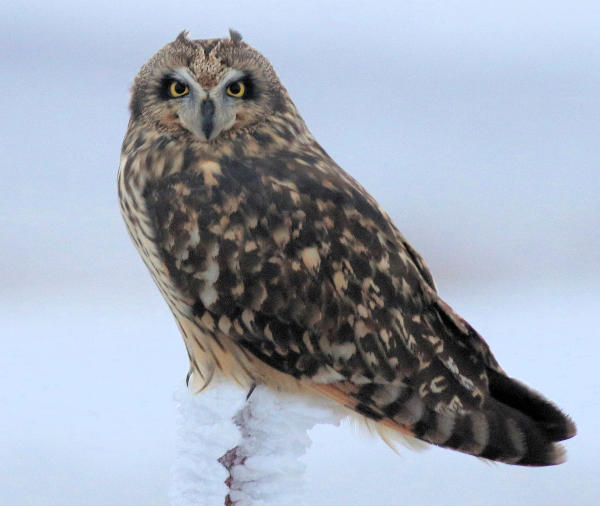
Paul’s first photo of a Short-eared Owl this season was the result of some time spent well in the company of a new prairie visitor. Although Paul wrote that this owl was his “new friend,” it doesn’t look all that friendly.
|
We’ve all had a “bad” day of birding, but I had a bad week of birding. Weather plays an integral part in birding and in our birding “successes.” Last week was dominated by fog, for days and days, with no sunshine all week. Is that even possible? (Ha-ha) But despite the weather, Thursday offered some brighter possibilities when I flushed a flock of about a dozen Snow Buntings – the first pure Snow Bunting flock – the other Snows I’ve seen this season have been in big mixed-species flocks.
Not far down the road from the buntings (about 16 miles east of home), I could see what I expected to be a distant Prairie Falcon in flight, as judged by its size, shape and shallow wingbeats. I was delighted to see it fly low to a perch just a few feet north of the rural roadway. I pulled up a little short of where I really wanted to be for a photo attempt, but the young female Prairie Falcon wasn’t fazed by my approach.
I studied her features and her blue cere, dark eyes and immaculate plumage were distinct. When she was ready, she took flight, straight into the wind, which held her motionless for a moment, then the elegant Prairie sliced the breeze at a slight angle toward me, but above me, as though she was in slow-motion. She flew south for a couple hundred yards before pulling up on another perch amid the vast white prairie landscape.
Even though light conditions were not good for photography, I needed to feel the fun and excitement of trying to get an acceptable image – essentially going through the motions for a thrill. But when I reviewed my photos, a couple were rather acceptable. When reflecting on my poor week of birding as I write this, just seeing the bird is enough for many birders. I saw two relatively rare species within 15 minutes, both in flight; and these species would represent life birds for many birders. In retrospect, it’s really a matter of perspective sometimes.
Last minute addition: Monday, same weather but with thick hoarfrost covering everything. Big change: The birds made a breakthrough for me. It began with a little change at the thistle feeder where an American Goldfinch camped out for most of the afternoon among the usual visitors. Late afternoon I thought a second finch had joined in, but a second look revealed the second bird was the first Pine Siskin of the season, and it was soon joined by the second siskin – Nice.
As I forced myself down the road with little hope of bird lightning, I was jolted into reality about seven miles south where I had a double lightning strike! I barely had a chance to react to my first Short-eared Owl of the season when within the same view, just 150 yards south a similar-sized bird took flight, so I drove forward to see if it was another Short-ear or . . . Pretty quick I realized it was probably a Prairie Falcon, and I was able to verify that sighting and “follow” it’s flight south until it dipped below a low hill, not to be seen again.
I returned to the owl, which I watched from a distance for a bit, then tried to position closer. Without showing any concern for my approach, I enjoyed some personal time monitoring the owl as it searched the area in hunting mode. The owl’s ears were very obvious at close quarters, even though they were barely an inch in length. I took a few nice photos too – nice if there was a hint of light – but I enjoyed the encounter for what it was.
Well, that changes everything; now I was geared for more avian excitement, and four miles south of my new friend the Short-ear, I found a small very dark-colored Great Horned Owl perched on the top of a snag on the edge of a tree grove. This male was definitely not a local owl, which are colored brown and gray, as this small male looked dark-gray to black with white and gray barring on the breast. I would expect that this dark owl migrated from the deep forests of Canada. I took a couple documentary photos of it, and drove less than a mile farther south only to find a not-as-dark but larger female Great Horned Owl. The female was a bit farther away, but she appeared to be mostly medium to darker gray in color.
Well, I guess I deserved a little birding excitement today, and there’s sunshine in the forecast, which could mean a quick trip south, but I’ll fill you in next week if it works out.
Article and photo by Paul Konrad
Paul Konrad is the Editor of The Birding Wire; share your sightings or photos at editorstbw2@gmail.com